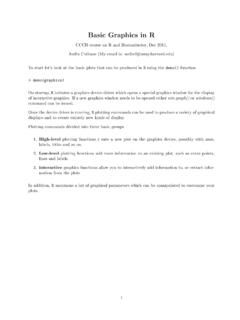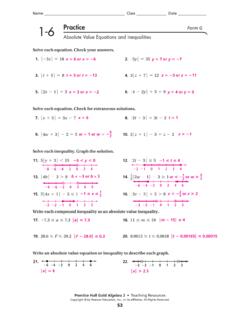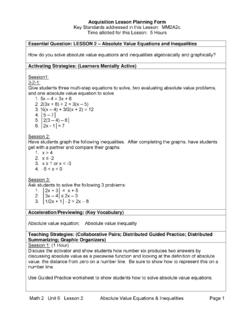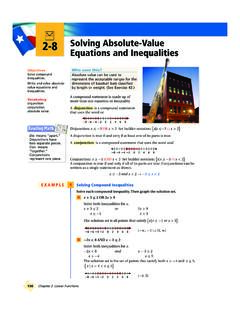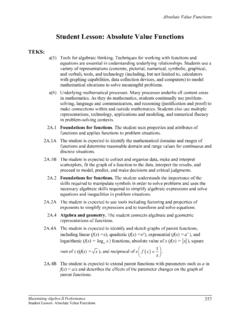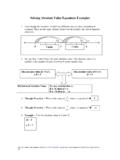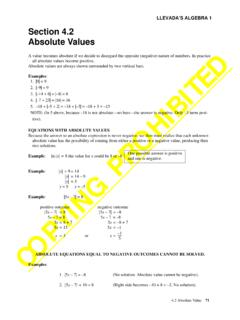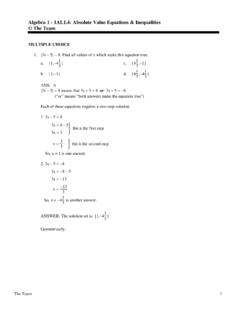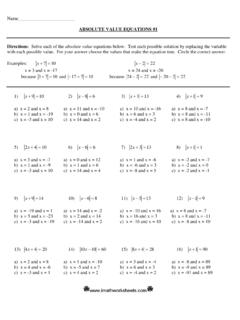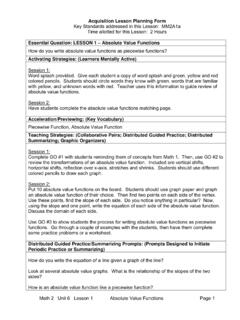Transcription of Session 3 Solving Linear and Quadratic Equations and ...
1 Session 3 Solving Linear and Quadratic Equationsand absolute value Equations1 Solving EquationsAnequationis a statement expressing the equality of twomathematical expressions. It may have numeric and variable termson the left hand side (LHS) and similar terms on the right handside (RHS):LHS = RHS3x+2=27x 4We want tosolvethe equation, which means we want to get thevariable by itself on the left side and the numeric values bythemselves on the right side, if EquationsSolving an equation means finding the value (s) the variable cantake on to make the equation a true statement. Sometimes thereare no such values:x=x+1 Sometimes there are multiplesolutions:x2=4 This equation has twosolutions: 2 and Linear EquationsTo solve Linear Equations , we can use the additive andmultiplicative properties of additive property of equality:Ifa=b, thena+c=b+ we choosecto be the additive inverse of a term, we can add orsubtract it from both sides of the equation, and take steps toisolate the variable +x=53 3+x=5 3x=24 Solving Linear EquationsThe multiplicative property of equality:Ifa=b, thenac=bcIf we choosecto be the multiplicative inverse of a term, we canmultiply both sides of the equation by the multiplicative inverseand get rid of or divide out a coefficient on the variable we aretrying to isolate.
2 (35)x=10(53)(35)x=(53)10x=5035 Steps in Solving Linear Equations1. Remove all parentheses by using the distributive Use the additive property of equality to move all variable termsto the LHS and all constant terms to the Simplify by combining like Use the multiplicative property of equality to change thecoefficient of the variable to Simplify the RHS. When the variable is alone on the LHS, theRHS is the solution to the Check your answer by plugging the solution back into theoriginal equation. (Always!)6 Example: Solving Linear Equations3(x 2) + 3 = 2(6 x)3x 6+3 = 12 2xDistributive property3x 3=12 2xCombine like terms3x+2x 3=12 2x+2xAdd 2xto each side5x 3 = 12 Combine like terms5x 3 + 3 = 12 + 3 Add 3 to each side5x= 15 Combine like terms(15)5x=(15)15 Multiply each side by15x= 3 This is the solution3(3-2) + 3 = 2(6-3)?
3 Check your answerYes!7 Finding Linear EquationsIf you know two points, (x1,y1) (the x and y coordinates of thefirst point) and (x2,y2) (the x and y coordinates of the secondpoint, you can find the equation for a line:1. The slope is the change in y divided by the change in x:m=y2 y1x2 x1= y x2. Set up a formula in the standard form, using the slope youcalculatedy=mx+b3. Substitute x and y values for one of the points and solve for b4. Check your answer using the x and y values for the other point(Always!)8 Example: Find the Equation for a LineSuppose you have two points (-1,0) and (2,6) and you want to findthe equation for the line through those two 9 Example: Find the Equation for a Line1. The slope is the change in y divided by the change in x:m=y2 y1x2 x1=6 02 ( 1)=63=22. Set up a formula in the standard form, using the slope youcalculatedy=2x+b10 Example: Find the Equation for a Line3.)
4 Substitute the x and y values for one of the points (2,6) andsolve for b6 = 2(2) +b6=4+b6 4=b b=2y=2x+24. Check your answer using the x and y values for the other point0=2( 1) + 2? Yes!11 Example: Find the Equation for a Liney=2x+2-10123456-10123456 12 Another Way to Find the Equation for a LineWe have been using the slope-intercept form of the equation for aline. Another way to find the equation for a line is to use thepoint-slope y1=m(x x1)m=slope(x1,y1) = one point on the lineSo, given slope = 2 and point (x1,y1)=( 1,0):y 0=2(x ( 1))y=2x+2 Same as before!13 Solving Quadratic EquationsYou may need to find the solution to a Quadratic equation. To dothis, you must use the distributive, additive, and multiplicativeproperties to get the equation into this form:ax2+bx+c=0 Then you can pluga,b,andcinto the following equation, which iscalled thequadratic b b2 4ac2a b2 4acis called Quadratic EquationsThe solution to a Quadratic equation specifies where it crosses the xaxis.
5 A Quadratic equation may have 2 solutions: 5 4 3 2 1012345 5 4 3 2 1012345A Quadratic equation may have no solutions: 5 4 3 2 101 101234515 Solving Quadratic EquationsA Quadratic equation may have one solution:01234501234516 Solving Quadratic Equations : Example3(x2+2x)+2 = x2 6x 43x2+6x+2 = x2 6x 44x2+6x+2 = 6x 44x2+6x+6 = 6x4x2+12x+6 = 0 Soa=4,b=12andc= Quadratic Equations : Examplea=4,b=12,c=6x= b b2 4ac2ax= 12 122 4(4)(6)(2)(4)x= 12 488x= 128 488x= + = = two solutions are and Quadratic Equations : ExampleCheck the solutions:4x2+12x+6 = 04( )2+ 12( ) + 6 = + 6 = 04( )2+ 12( ) + 6 = + 6 = 0 Good!19 Solving Quadratic Equations : ExampleWe can graph Quadratic Equations in a manner similar to that forlinear functions:y=4x2+12x+6xy06-1 -2-2 Quadratic Equations -3 -2 -1 0 1-2-101234567 21 Solving Quadratic Equations : ExampleRecall the 8 animals who received different doses of a drug andwhose weight gain was measured.
6 The Quadratic equation that bestdescribed the relationship between dose and weight gain was:y= + can use substitution to find the predicted weight gain, given adose. For example, if we know an animal like these received dose 3,we would predict that the weight gain would (3) + (3)(3) = if we knew the animal had gained 5 dekagrams, and wantedto deduce what the dose had been?22 Solving Quadratic Equations : ExampleHint: Before getting tangled up in arithmetic, think about what areasonable solution might be. Recall:Dose Weight Gain (dekagrams) the animal gained 5 dekagrams, the dose was probably between 6and Quadratic Equations : ExampleHint: When possible, draw a 24 Solving Quadratic Equations : ExampleIf the animal had gained 5 dekagrams, substituting fory,y=5 = + 5= 5 + can use the Quadratic equation witha= ,b= ,c= Quadratic Equations : Examplex= ( )2 ((4)( )( ))(2)( )x= + or should go back and check these!
7 26 Solving Quadratic Equations : ExampleThe solutions to the equation are and Do both ofthese make sense in the context of our problem? No - animalscannot receive a negative dose! We are only interested in solutionsgreater than zero. The predicted dose is (We can envision adose bigger than 6, but less than 7.) This agrees with our bestestimate before doing the value EquationsRecall: absolute valuerefers to a number s distance from 0 onthe real number | 5|=5|2|=2|0|=0|a b|is the absolute value of (a b), or the distance from a to bExample:|5 3|=228 absolute value Equations -5-4-3-2-1012345|a+b|can be thought of as|a ( b)|, or the distance betweenaand b.|5+3|=|5 ( 3)|, or the distance betwen 5 and -3, or 8.| a b|=| a (+b)|, or the distance from atob| 5 3|=| 5 (+3)|=| 8|=829 Solving absolute value Equations -5-4-3-2-1012345|a|= 5 means, What values ofaare 5 units away from 0?
8 Solutions: 5 and -5|a 3|= 2 means, What are the values ofasuch that the distancebetweenaand 3 is 2? We can deduce the answer by finding 3 on the number line andfinding the values 2 units away from , we can solve the equationsa 3=2anda 3= 5 anda=130 Solving absolute value EquationsSolve5 |3x+5|=3 Subtract 55 5 |3x+5|=3 5 Simplify |3x+5|= 2 Mult. by -1( 1)( |3x+5|)=( 1)( 2)Simplify|3x+5|=2 Solveseparately3x+5=23x+5= 2 Subtract 53x+5 5=2 53x+5 5= 2 5 Simplify3x= 33x= 7 Mult. by13(3x)(13)=( 3)(13)(3x)13=( 7)13 Solutionsx= 1x= 7331 Solving absolute value EquationsHighly recommended: Check your solutions by plugging them backinto the original equation:5 |3( 1) + 5|?=35 | 3+5|?=35 |2|?=5 2=3 Yes!5 |3( 73)+5|?=35 | 7+5|?=35 | 2|?=5 2=3 Yes!32 Solving absolute value EquationsNote that simplifying absolute values should come early in theorder of operations, similar to brackets and parentheses.
9 |3x+5|= 2 is not the same as|3x|+5=233 Example: Using absolute Values in StatisticsYou are studying the relationship between head injury and helmetuse among people involved in bicycle accidents (Pagano andGauvreau, page 311).You have information for 793 people involved in accidents. Ofthose, 147 people were wearing helmets and 235 people experienceda head injury. You can make a table that illustrates what youknow, and add what you would expect to see if there were noassociation between helmet use and head injury:Wearing HelmetYesNoTotalHeadYes235 Injury NoTotal14779334 Example: Using absolute Values in StatisticsHere is the table ofexpectedvalues we just created:Wearing you add the information you have about helmet use amongpeople who experienced a head injury, here is what youobserved:Wearing Helmet YesNoTotalHeadYes17 218235 Injury No130 428558 Total147 64679335 Example: Using absolute Values in StatisticsWe can use a test statistic to see whether the difference betweenobserved and expected values is big enough to signify that wearinghelmets is associated with fewer head injuries.
10 Here s what the teststatistic looks like: 2=4 i=1(|Oi Ei| )2Ei4 i=1means add the first through the 4th of what comes nextOiis the observed value for positioni, whereiis either 1, 2, 3, or 4 Eiis the expected value in the corresponding position 2(Chi-squared) is the name of this particular test statistic36 Example: Using absolute Values in Statistics 2=4 i=1(|Oi Ei| )2Ei 2=(|17 | ) +(|130 | ) +(|218 | ) +(|428 | ) + + + does this mean? Is there an association between helmet useand head injury? Stay tuned!37 InequalitiesAn inequality is like an equation, but it says that two =bais not equal toba<b ais less thanbaba>b ais greater thanbbaa bais greater than or equal toba bais less than or equal tobNote that less than means to the left on the number line and greater than means to the right on the number line.
